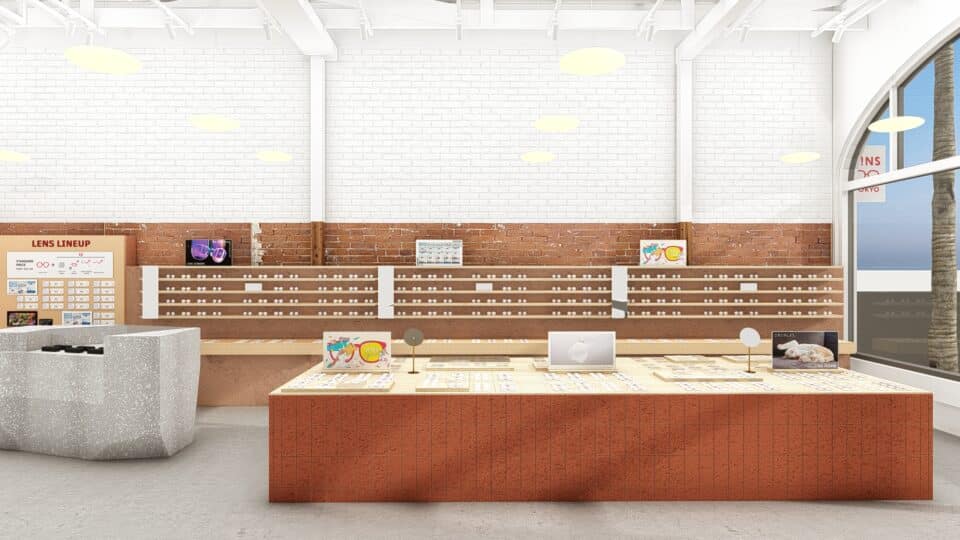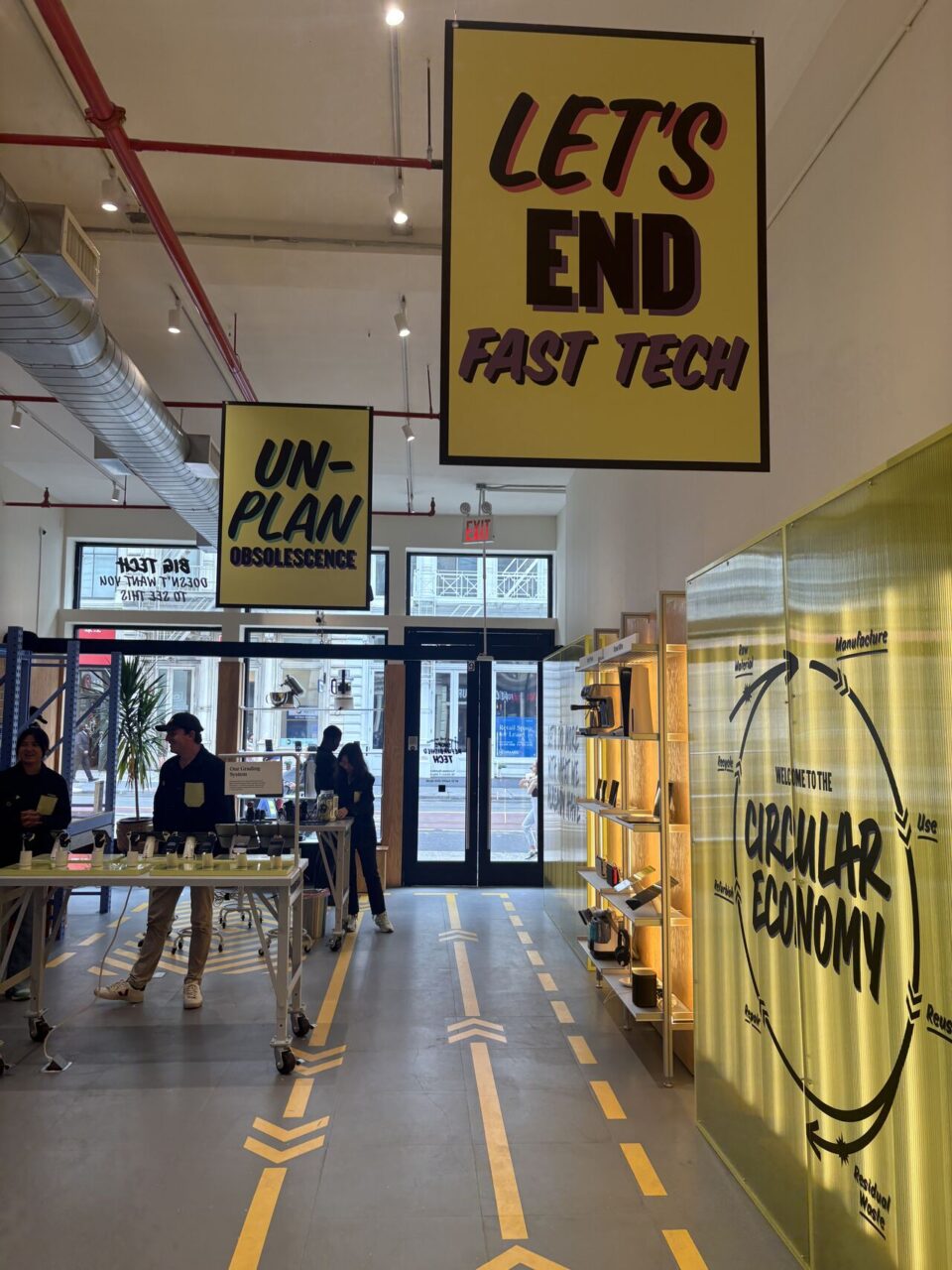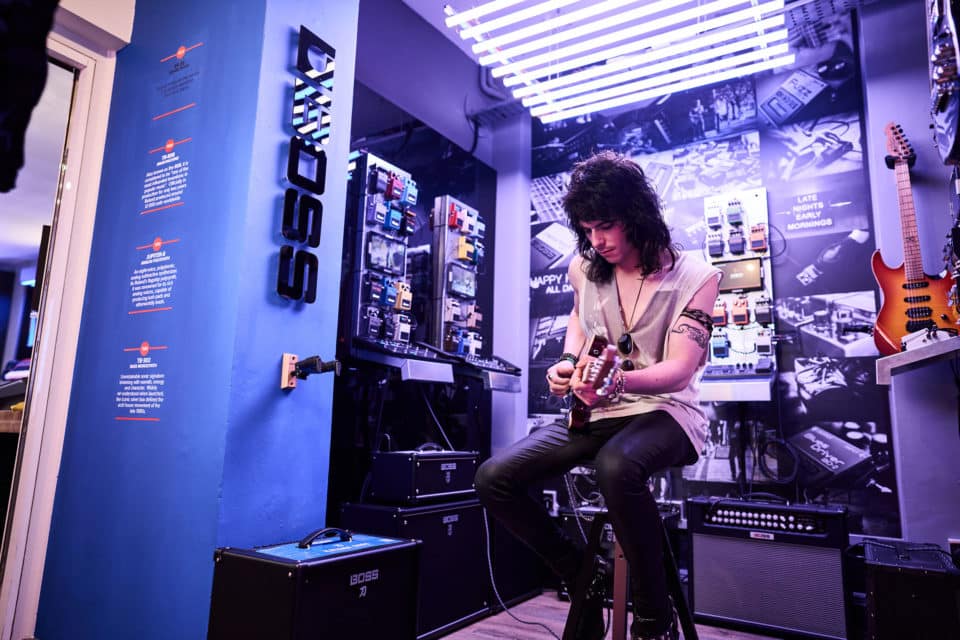Formula for success – How F3G is using tech to create the retail set-up of the future
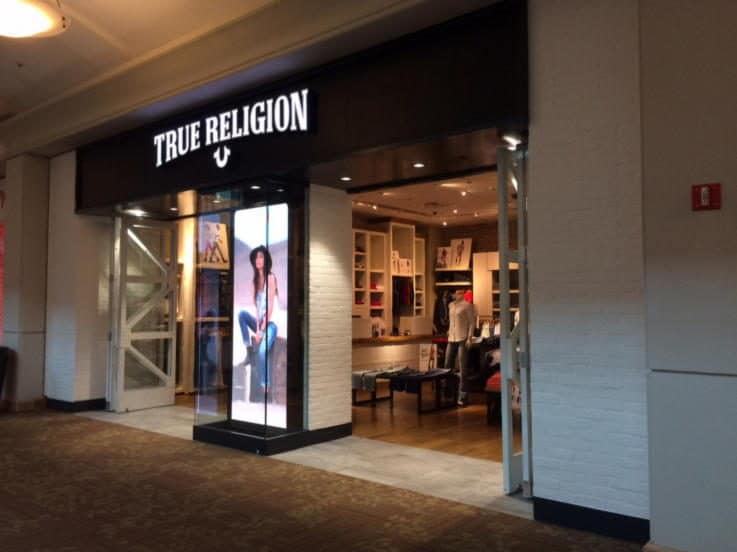
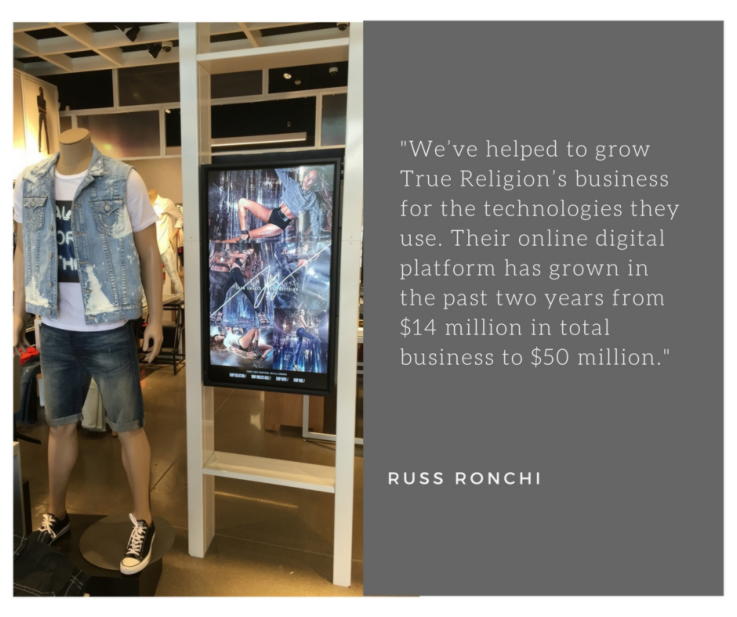
F3G were one of the most exciting companies at this year’s NRF. Their omnichannel-enabling digital technology is firmly focused on the retail store of the future. Making firm use of cloud technologies, the company has already proven its worth in helping True Religion take its online business to $50 million.
We spoke to CEO Russ Ronchi about the True Religion project, the store of the future and the next phase of F3G’s offering.
Could you tell me what F3G does in a nutshell?
F3G is a digital agency in Southern California that specialises in omnichannel technology for the retail space. We blend and bring together the best of the digital world with the retail world. We believe that there is no future in looking at your digital channels and your retail channels separately. Those channels are one and the same, it’s just how you reach your customer. What we try to do is bring technology to enable that process and make the experience benefit the customer.
How big is the company?
The organisation is split into two groups. We have our product team which is currently six people and they’re the people that are really behind me on the omnichannel platform. Then we have about 15 people that are on our services side.
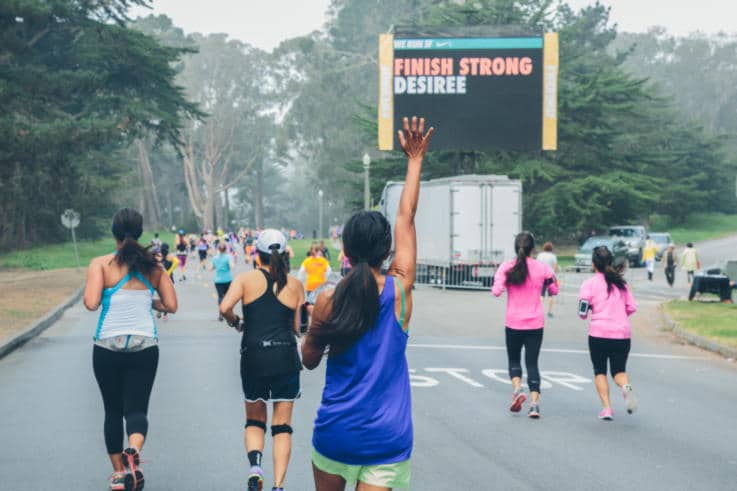
Of your recent retail projects, which would you say is the most innovative or future focused?
Generally speaking when we go in and talk to retailers they start to come up with reasons why they can’t do things. Because they’ve been thinking in the same way for so long. There’s always that mentality of oh, we can’t do that because of this, we can’t do this because of that.
We have done a lot of projects for Nike in the past. We started up purely in the digital space and made the jump into the physical space with Nike. They challenged us to figure out how we could bring some of the experience that you would find in a typical online environment into an actual physical space.
We did a project for them for the Nike Women’s Marathon, which has about 38,000 participants enrolled. It is very actually one of the largest US based running events but it’s not like a typical city marathon.
Nike have this running platform called Nike Plus and there’s a function inside the app called Share Your Run. So as you’re doing your run it will post to your social networks and say, ‘hey Cate just started to run’. If someone hits the like button there’s a little cheering sound. It’s quite cool.
They said, ‘hey look, we love our cheer me on project but how do we bring that to a larger format?’. We did that by putting RFID tags on the runners bibs, so we could locate where every runner is. We also knew what their pace is.
We set up these large concert sized LED screens and we were able to message the runners as they ran by. We were able to flash up their names on the screen and message them as a source of inspiration and give them uplifting quotes. These women who were running in the race didn’t know that this was going to happen.
If they had connected their social media accounts to their Nike Plus, we were able to flash up on the screen photos of people who had liked their post or who had typed them a message. So, we got women who were crying on the racetrack because they’re so moved by seeing these messages on the screen. It was a rising success in that you could take a concept of something that you find in the digital space and bring it to an athletic event. And in a way that was a surprise but also accurate as well.
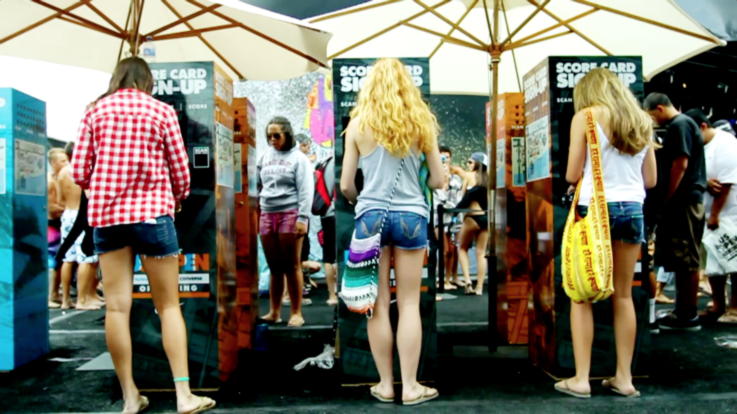
Has that project given you any new ideas about how you think the store of the future might evolve?
Yes, because people are craving that attention. It’s the same reason that most folks are posting on Instagram and those types of social networks. There’s nothing wrong with it – everybody wants their fifteen seconds of fame, right? When you’re bringing a level of personalisation and acknowledgement, you have to take the approach of anything that will differentiate your experience from the next, is a serious value proposition.
In the past our realm of influence was very narrow. It’s like when you go shopping, it would be like your local mall. There are your touch points right there. You’re influenced by what is readily available to you within driving distance, on the television, the radio, newspapers, magazines etc. It’s a very limited and narrow scope of influence.
Nowadays, you have alternate influence from any number of millions of channels, content, blogs. Everybody is a content provider now. Your realm of influence went from half a dozen, to six hundred, six thousand touchpoints. Your realm of influence is exponentially larger. Long ago is the day that when you’re shopping for something you just go to your local mall.
Now whatever is the flashiest, brightest object in your view for that day gets your attention. It’s not about how we get people walking around in the malls. How do we get people to actually come to the store with the value proposition? Things as basic as doing special market units that only get sold in retail locations.
In high-end retail they’re creating a lot more experiential things. You go to the Nike store now and they’ve got a full DJ set up in there blasting music all hours of the day. They’ve got a half-court basketball court in there. They’ve got a soccer set-up where you can try on shoes and do some corner kicks and some penalty kicks.
More of the retail space is dedicated to experience than is dedicated to products. That’s really where we see the store in the future going. It’s not about how many pieces of clothing or shoes you can stick on the wall. It’s about experience that drives the brand and ultimately the purchasing of the product.
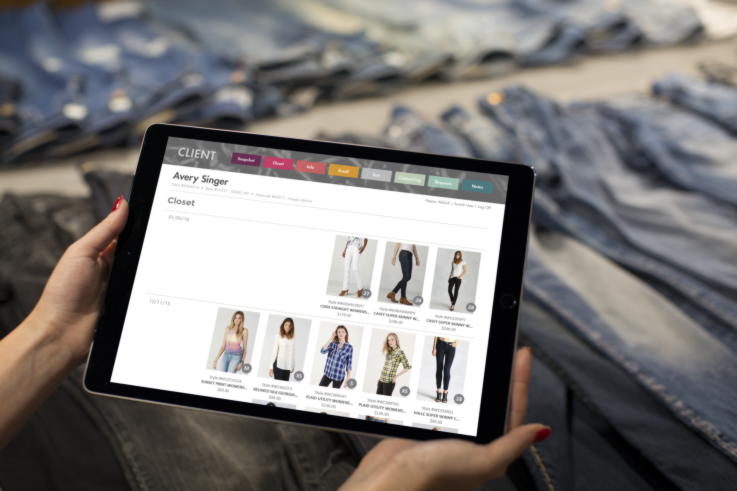
How does your technology enable that?
Our MILO Omnichannel Suite enables a high level of customer service in an automated sense from the customers’ standpoint. From the corporate standpoint, it allows them to make decisions on the fly in real-time about what their top performers are.
What’s become very interesting is that for any store that’s in prime real estate in Manhattan the customers outnumber the assistants by 10 to one. I know in the Macy’s store in Manhattan, you can wait for over 20 to 30 minutes in the shoe department just for an associate to come and ask you what size you wear. That’s reported by their own staff. So, you can think about the opportunities you’re losing, that you’re able to augment with self-service technology.
On the other side, True Religion is considered luxury retail. Any time you pay $300 dollars for a pair of jeans, it’s considered luxury. In their world it’s not about self-service. It’s about a relationship with the customer. But when you’re a horizontal retailer, it’s about numbers, about creating efficiencies.
You can use technology in True Religion, as John Hazen says, to slow the customer down. He wants to use things like digital signage and the tools that he’s implemented in True Religion, to draw the customer into the store. And to create a more rich and compelling experience, while the customer is working with an associate.
In luxury retail, it’s about a relationship. It’s about taking the person that goes in to buy one pair of jeans and you want them to leave with a pair of jeans and a top. But then you talk about a horizontal retailers and they’ve got thousands and thousands of people walking through their doors every day.
They don’t have enough associates to create those one-on-one relationships. That’s not their business model. Their business model is to a certain extent about extreme efficiencies. You can use the same technology to create efficiencies and automation, as well as create human connection and slow the customer down.
When we think about the store in the future, every single piece of technology that we develop and that we put into our platform has got to go through that lens.
You created a complete omnichannel system for True Religion (digital signage, endless aisle, clienteling and product information management) – how has that performed?
We’ve helped to grow True Religion’s business for the technologies they use. Their online digital platform has grown in the past two years from $14 million in total business to $50 million. Obviously, we can’t take all the credit for that, but it’s all powered by our digital platform that we’ve installed.
The flagship success story is our clienteling platform. It has been such an amazing success and far exceeded their wildest dreams and hopes for what we achieved. They soft-launched at the start of 2016 and they didn’t make their sales assistants use it for pretty much that first year. They do now.
The idea of clienteling is the maintenance of the relationship between all the existing customers in the store. It’s not new customer acquisition. It’s getting the people to come back into the store to then buy.
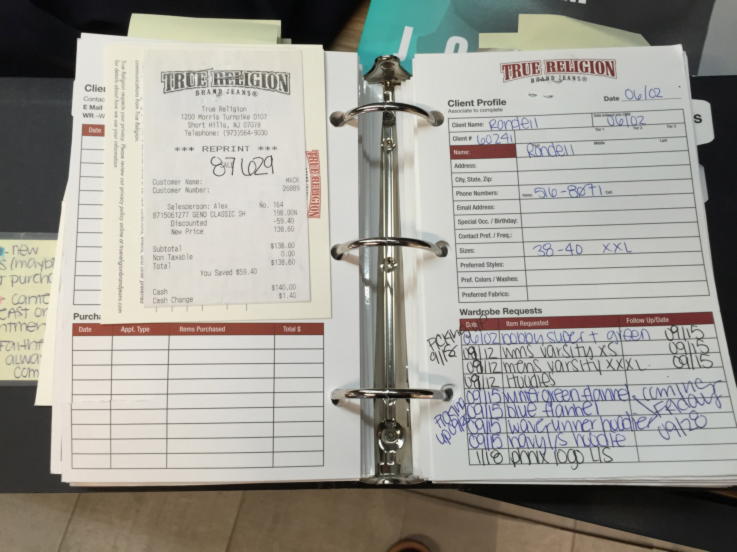
What we saw before we implemented our clienteling platform was they were literally using black binders. And they would put tabs and handwrite notes about the customer. There’s no way to search this analogue book, there’s nowhere to set reminders in this book, there’s no way to prompt me to do something out of this book.
When I get a new shipment in of say black jeans, I have to go back in my book and go, ‘do I have anybody that bought black jeans?’. ‘Do I have anybody that bought this style of jeans?’. ‘Is there anyone that I can call and see if they would like this?’. It’s just a horrible experience.
Not only that, but there’s a scientific law called Magical Number Seven (Plus or Minus Two). It says that human brain can only keep seven (plus or minus two) relationships front of memory. When you think about how many people an associate sells to in a given month, maybe 50, 100 or more, all of those people you are leaving on the table. That’s a lot of money you’re leaving on the table because you can’t remember all those relationships.
We installed that clienteling platform and created a series of automation and efficiencies out of it. Before they averaged 0.1% client purchases – they define a client as a repeat customer. Now on average, 10% of their total sales in their stores are client sales. It’s just incredible growth and it’s incremental business.
When you take a combination of clienteling, the endless aisle screen (where you can shop the inventory of the entire fleet), in-store fulfilment and their off-price website business, that’s what is responsible for growing the business to $50 million.
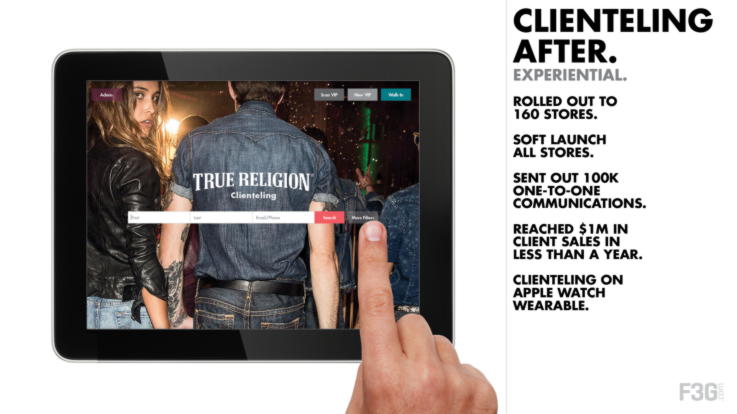
What are the main things you’ve learnt from the True Religion project?
When we talk about our current suite of products and what we’re trying to do and innovate in retail, True Religion is definitely at the forward end of that.
In designing our platform, we took the approach that for all the software that we design you should not need a manual. It’s important that we work with corporate in terms of figuring out business rules and understanding what the requirements are etc. But the people with boots on the ground, they’re the people that are living this day in and day out. And if you want really good information, go to them.
One of the things that we found was the old-school way of designing software was to jam as many features in as you can. Because that translated into value. The more features, the more value. Those values drastically changed over the past year, so that efficiencies and joy of use are now important to us.
When we take that into consideration, we think about simplicity, software that doesn’t need training. We want to try to turn it into a game as much as possible. If you buy something online with True Religion, they now offer in-store fulfilment. It’s been completely turned into a game.
What happens is when an order comes through on e-commerce it gets disseminated down to the store that’s got the best ability to fill that order. The store has the opportunity to reserve that order and if they can fill that within a certain amount of time, then they get a bonus from corporate.
So, making things fun, turning things into games, keeping things simple, and not requiring people to have to open a manual. If you can put your software in front of a millennial and not say a word and they can just use it, that’s ideal. That was the biggest thing that we learnt throughout the process.
Not only in working with True Religion, but in developing our platform and having it be successfully adopted into a place like True Religion. They have 150 stores and we’ve never once conducted a training seminar.
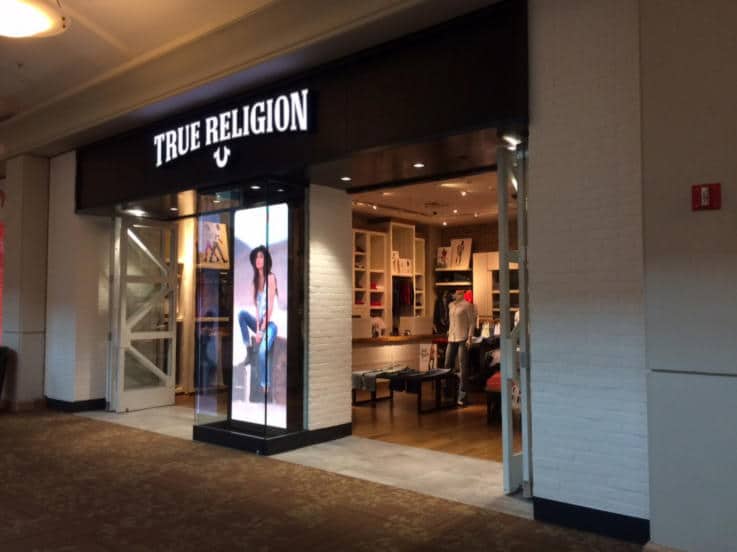
How far do you think we are from stores and displays that recognise the customer?
We’re actually working on prototyping technology that does exactly that facial recognition, as a part of our digital signage and our platform. People can think it’s creepy though. If I’m walking down the hallway in a mall and every single screen that I walk by in the corridors says, hi…hi…. I’m going to be a little creeped out by that.
But if I walk into a store that I do a lot of shopping at, that I freely give my information and they greeted me by name, I would have no problem with that. I think most people have their favourite brands and they’re okay with them knowing some information about them. I think that’s absolutely a part of the future. Everybody wants to be recognised. It’s part of the human psyche that we want acknowledgment.
When you’re greeted by name, it’s a powerful thing. If I walk in and I see you and I say, ‘hi nice to see you’, that’s one thing. But if I say, ‘Hi Cate’, it’s a wonderful feeling. That’s going to elicit a more pleasurable response to your brain than you just saying hi.
That level of personalisation is absolutely the next phase of this. Its evolution will go to that. It’s just how we leverage the perception of creepiness, especially with all of the security issues in cyber space.
We have to be responsible about that. We have to acknowledge the elephant in the room and say, can you get it? If I go into a store and buy some underwear, and I walk back into the store with some friends, and it say’s ‘welcome back, how did you like that underwear that you bought’ – that’s embarrassing.
I think that’s the perception that people automatically think that when you have some sort of knowledge of who they are, that you’re going to release their secrets. It’s a matter of earning the trust of the consumer to say yes. You can walk into your favourite store and there are going to be lots of digital interactions and touch points where we are going to know who you are by your face. Then we are going to be able to access things that you purchased in the past. And be able to make more meaningful recommendations of what you might like to see in the future.
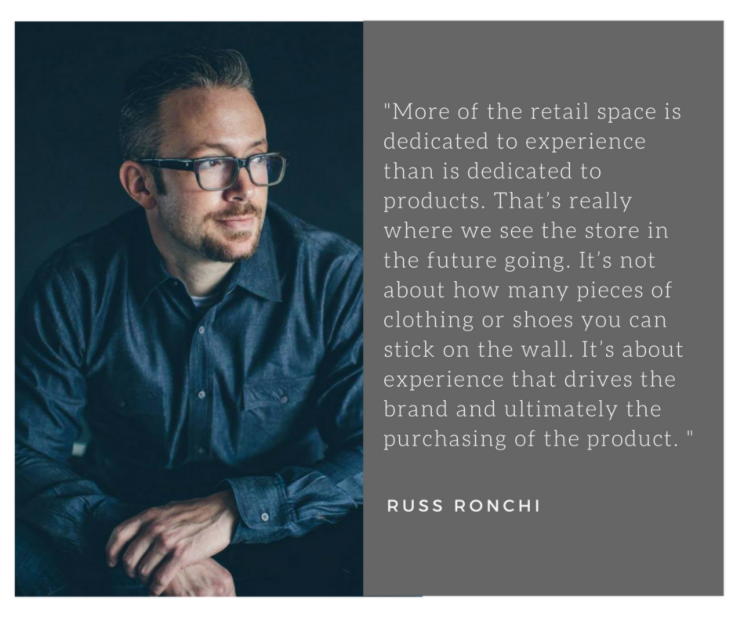
As a customer when can I step into a store that will offer me this?
I wouldn’t be surprised if you start to see it within the next year. The first stage of it is going to be used simply from a visual signage perspective. You’ll see this by the end of the year. This is really the first layer of our offering. We are going to be releasing it into some True Religion stores this year. So we will know that you have walked into a True Religion store and we’ll know your general age.
We won’t know specifically, obviously, but this technology allows us to make a fairly educated guess about your age. It is completely anonymous data. We don’t record anything.
That image recognition can do four or five things fairly well – we can guess your gender, we can guess your age range, we can guess if you’re happy or confused or upset or what not. So, when you’re thinking about showing different products and cross sales or up-sales, you can flash something in front of the person on the screen. If their facial expression changes to one that is registered as confused or upset, sad or somehow not targeted, you can rapidly change the display. You can continuously show things until you register a positive emotion on their face.
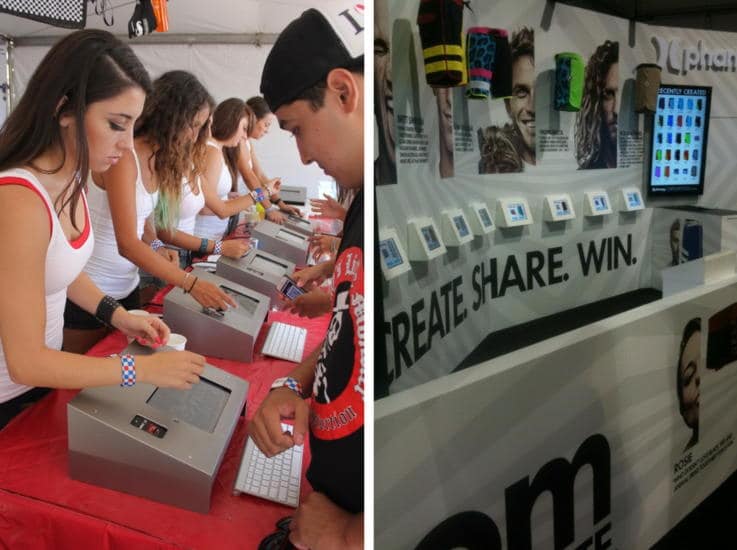
What three retail technologies are you most excited about at the moment?
I think some of the popular answers are things like VR and augmented reality. I think the jury is still out on that stuff. I’m not saying it doesn’t have a place. But anytime that you have to create all of these extra touchpoints, like extra equipment, I think that becomes a little bit more difficult to sell.
The technologies that get me excited, is the evolution of what the phone brings in terms of payment. When you’re enabling people to create frictionless transactions through their phone, that enables a whole array of opportunities in a more experimental space. Certainly, you see evidence of this with what Amazon is trying to do with some of the grocery store ideas. In that you just go into the store and you scan things, hit a button on your phone and walk out and then it delivers to your house. The frictionless transactions are really exciting for me.
The idea of RFID and NFC and all the different technologies that we can use to identify a person or wayfinding becomes exciting to be able to show those experiences. I think primarily, using existing technology in new creative ways is the most exciting thing. As part of the store of the future initiative that we’re doing, we’re going for mostly screens, very little inventory and pretty much ship to house.
But we’re also doing things from an elevated clientele level, where you’re able to do complete 360 degree scans of your body and upload that into your profile in the store. So that you can go back later and say, ‘how did I look in this?’ and get crowdsourced opinions of what should I wear to the formal or whatever it is that you’re going to.
It’s really the existing technologies in new and creative ways that have the faster rate of adoption.
Images courtesy of F3G

